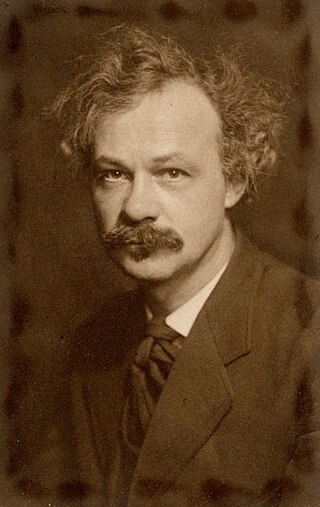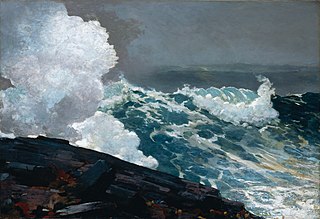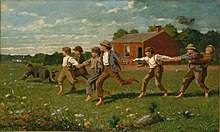
Frederic Edwin Church was an American landscape painter born in Hartford, Connecticut. He was a central figure in the Hudson River School of American landscape painters, best known for painting large landscapes, often depicting mountains, waterfalls, and sunsets. Church's paintings put an emphasis on realistic detail, dramatic light, and panoramic views. He debuted some of his major works in single-painting exhibitions to a paying and often enthralled audience in New York City. In his prime, he was one of the most famous painters in the United States.

Winslow Homer was an American landscape painter and illustrator, best known for his marine subjects. He is considered one of the foremost painters of 19th-century America and a preeminent figure in American art in general.

Andrew Newell Wyeth was an American visual artist, primarily a realist painter, working predominantly in a regionalist style. He believed he was also an abstractionist, portraying subjects in a new, meaningful way. The son of N. C. Wyeth and father of Jamie Wyeth, he was one of the best-known U.S. artists of the middle 20th century. James H. Duff explores the art and lives of the three men in An American Vision: Three Generations of Wyeth Art. Raised with an appreciation of nature, Wyeth took walks that fired his imagination. Henry David Thoreau, Robert Frost, and King Vidor's The Big Parade (1925) inspired him intellectually and artistically. Wyeth featured in a documentary The Metaphor in which he discussed Vidor's influence on the creation of his works of art, like Winter 1946 and Portrait of Ralph Kline. Wyeth was also inspired by Winslow Homer and Renaissance artists.

Jerome Myers was an American artist and writer associated with the Ashcan School, particularly known for his sympathetic depictions of the urban landscape and its people. He was one of the main organizers of the 1913 Armory Show, which introduced European modernism to America.

William Merritt Chase was an American painter, known as an exponent of Impressionism and as a teacher. He is also responsible for establishing the Chase School, which later became the Parsons School of Design.

Frank Weston Benson, frequently referred to as Frank W. Benson, was an American artist from Salem, Massachusetts known for his Realistic portraits, American Impressionist paintings, watercolors and etchings. He began his career painting portraits of distinguished families and murals for the Library of Congress. Some of his best known paintings depict his daughters outdoors at Benson's summer home, Wooster Farm, on the island of North Haven, Maine. He also produced numerous oil, wash and watercolor paintings and etchings of wildfowl and landscapes.

The Butler Institute of American Art, located on Wick Avenue in Youngstown, Ohio, United States, was the first museum dedicated exclusively to American art. Established by local industrialist and philanthropist Joseph G. Butler, Jr., the museum has been operating pro bono since 1919. Dedicated in 1919, the original structure is a McKim, Mead and White work listed on the National Register of Historic Places.

The Gulf Stream is an 1899 oil painting by Winslow Homer. It shows a man in a small dismasted rudderless fishing boat struggling against the waves of the sea, and was the artist's statement on a theme that had interested him for more than a decade. Homer vacationed often in Florida, Cuba, and the Caribbean.

The New Britain Museum of American Art is an art museum in New Britain, Connecticut. Founded in 1903, it is the first museum in the country dedicated to American art.

By the Seashore is a painting by Pierre-Auguste Renoir completed in 1883 and is now housed in the Metropolitan Museum of Art in New York City.

Kenneth Hayes Miller was an American painter, printmaker, and teacher.

The Boat Builders is an oil painting on panel executed in 1873 by American landscape painter Winslow Homer. It is held in the collection of the Indianapolis Museum of Art (IMA), in Indianapolis, Indiana, United States.

The Bright Side is an oil painting by the American artist Winslow Homer. Painted in 1865, the concluding year of the American Civil War, the work depicts four African American Union Army teamsters sitting on the sunny side of a Sibley tent. The painting is in the collection of the Fine Arts Museums of San Francisco-(De Young)

Allen Butler Talcott was an American landscape painter. After studying art in Paris for three years at Académie Julian, he returned to the United States, becoming one of the first members of the Old Lyme Art Colony in Connecticut. His paintings, usually landscapes depicting the local scenery and often executed en plein air, were generally Barbizon and Tonalist, sometimes incorporating elements of Impressionism. He was especially known and respected for his paintings of trees. After eight summers at Old Lyme, he died there at the age of 41.

The Fog Warning is one of several paintings on marine subjects by the late-19th-century American painter Winslow Homer (1836–1910). Together with The Herring Net and Breezing Up, painted the same year and also depicting the hard lives of fishermen in Maine, it is considered among his best works on such topics.

Northeaster is one of several paintings on marine subjects by the late-19th-century American painter Winslow Homer. Like The Fog Warning and Breezing Up, he created it during his time in Maine. It is on display in the Metropolitan Museum of Art in New York. Viewers are presented a struggle of elements between the sea and the rocky shore. Winslow Homer excelled in painting landscape paintings that depicted seascapes and mountain scenery.

Searchlight on Harbor Entrance, Santiago de Cuba is an early 20th century painting by American artist Winslow Homer. It is currently (2018) in the collection of the Metropolitan Museum of Art.

A Basket of Clams is a mid-19th century watercolor by American artist Winslow Homer in the collection of the Metropolitan Museum of Art in New York City.

Moonlight, Wood Island Light is a late 19th-century oil painting by American artist Winslow Homer. The painting is currently in the collection of the Metropolitan Museum of Art in New York.

William Nichols is an American artist known for highly detailed, tactile landscape paintings that combine physical scale with intimacy. His work depicts unassuming gardens, forests, ponds, and streams rather than grand vistas, in dense, close-up screens of foliage, thicket or water that immerse viewers within the experience rather outside it. Nichols developed his mature style in the 1970s, combining painterly traditions going back to Impressionism with reemerging movements such as Realism and Photorealism; critic John Perreault called his approach, "Photo-Impressionism." He has exhibited throughout the United States and abroad, including at OK Harris Gallery in New York (1979–2013), the San Francisco Museum of Modern Art, Milwaukee Museum of Art, Butler Institute of American Art, Kaohsiung Museum of Fine Arts (Taiwan), and Gulbenkian Museum (Lisbon); his work belongs to many private and public museum collections. In addition to reviews in national publications, Nichols's work appears in several art historical surveys of Realism and landscape painting, including The Artist and the American Landscape and Contemporary American Realism Since 1960, among others. Critic Mac McCloud observed that Nichols's "meticulous craft and precise observation of shape, edge, color and light" rendered his work "almost beyond reality […] alive with growth and transformation, teeming with insects and sweltering weather and yet, in the eternal aesthetic paradox it is motionless." Gallerist Ivan Karp wrote, "the vital pulse" of Nichols's paintings defies "the conviction that 400 years of depictions of the natural world nullify the ability of living artists to produce landscapes of high consequence."





















